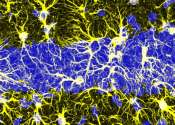Exploring how astrocytes respond to spinal cord injury or stroke-induced tissue damage
Past neuroscience studies found that when the central nervous system (CNS) is damaged, for instance following a stroke or spinal cord injuries, the lesions become surrounded by borders of newly proliferated astrocytes.









